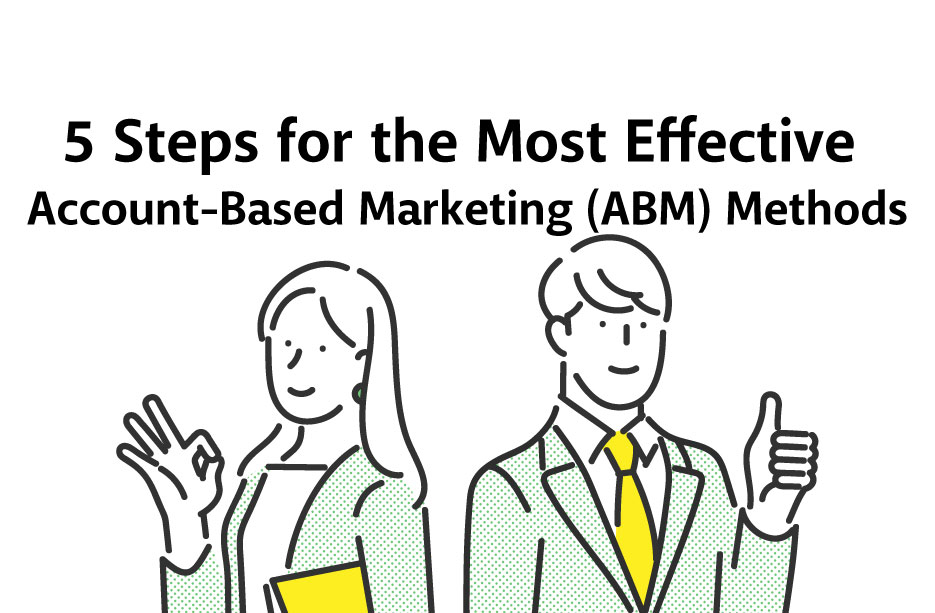5 Steps for the Most Effective Account-Based Marketing (ABM) Methods
Account-Based Marketing (ABM) is a targeted marketing approach that focuses on a select group of high-value accounts. Here are five steps for the most effective ABM methods:
- Identify the Right Accounts: The first step in effective ABM is to identify the right accounts to target. You can use data and analytics to determine which accounts are the most profitable or have the highest potential for growth.
- Personalize Your Approach: Once you’ve identified your target accounts, it’s important to personalize your approach. This means tailoring your messaging and content to the specific needs and pain points of each account.
- Use Multi-Channel Marketing: To effectively reach your target accounts, you need to use a variety of marketing channels. This might include telemarketing, email, social media, digital advertising, direct mail, and events.
- Coordinate Your Efforts: ABM requires close coordination between marketing and sales teams. You need to work together to ensure that your messaging is consistent and that you’re targeting the right people at the right time.
- Measure Your Results: Finally, it’s important to measure the success of your ABM efforts. This means tracking metrics like engagement rates, conversion rates, and revenue generated from your target accounts. Use this data to refine your strategy and optimize your results.
By following these steps, you can develop an effective ABM strategy that helps you win over high-value accounts and drive business growth.
What are the things to watch out for in ABM?
While Account-Based Marketing (ABM) can be an effective approach for many companies, there are a few things to watch out for:
- Targeting the Wrong Accounts: One of the biggest risks with ABM is targeting the wrong accounts. If you’re not careful, you can end up investing time and resources into accounts that are not a good fit for your business. Make sure you do your research and use data to identify the accounts with the highest potential for revenue.
- Lack of Personalization: ABM is all about personalization and tailoring your approach to the specific needs and pain points of each account. If you’re not taking the time to personalize your messaging and content, you risk losing the attention and interest of your target accounts.
- Poor Sales and Marketing Alignment: ABM requires close coordination between sales and marketing teams. If your teams are not aligned and working together, you risk creating a disjointed and ineffective approach.
- Overlooking the Buyer Journey: ABM can be effective in targeting high-value accounts, but it’s important not to overlook the broader buyer journey. You need to understand how your target accounts fit into the larger market landscape and tailor your approach accordingly.
- Limited Scale: ABM can be effective for targeting a select group of high-value accounts, but it’s not always the best approach for scaling your business. Make sure you consider the potential for growth and the long-term impact of your ABM efforts.
By being mindful of these risks, you can develop an effective ABM strategy that drives growth and revenue for your business.
In what cases is ABM effective?
Account-Based Marketing (ABM) can be effective in a variety of situations, including:
- High-Value Accounts: ABM is particularly effective for targeting high-value accounts that can generate significant revenue. By focusing your efforts on a select group of accounts, you can create a more personalized and targeted approach that resonates with decision-makers.
- Long Sales Cycles: ABM can be effective for companies with long sales cycles, as it allows you to build relationships and nurture leads over time. By targeting the right accounts with the right messaging, you can create a more efficient and effective sales process.
- Complex Sales: ABM can be effective for companies selling complex products or services that require a high level of customization. By tailoring your messaging and content to the specific needs of each account, you can demonstrate your understanding of their unique challenges and position yourself as a trusted partner.
- Limited Budget: ABM can be a more cost-effective approach than traditional marketing methods because it allows you to focus your resources on a select group of accounts. By targeting the right accounts with the right messaging, you can generate higher conversion rates and ROI.
- New Markets: ABM can be effective for companies looking to expand into new markets or industries. By targeting the right accounts with the right messaging, you can build awareness and generate interest in your products or services.
Overall, ABM can be effective in any situation where you want to create a more personalized, targeted approach to marketing and sales.
Summary
Effective ABM involves identifying high-value target accounts, personalizing messaging, aligning sales and marketing efforts, using technology to scale campaigns, and continuously measuring and optimizing performance. By following these steps, businesses can focus on the accounts that are most likely to bring them revenue, tailor their messaging to the specific needs of each account, and collaborate between sales and marketing teams to execute campaigns.
Technology such as account-based advertising, personalization software, and predictive analytics can help businesses scale their ABM efforts. Ongoing measurement and optimization is crucial to ensure the success of ABM campaigns.
IAD provides quality lead generation services based on our experience with more than 3,000 projects. Please feel free to contact us for more information.



